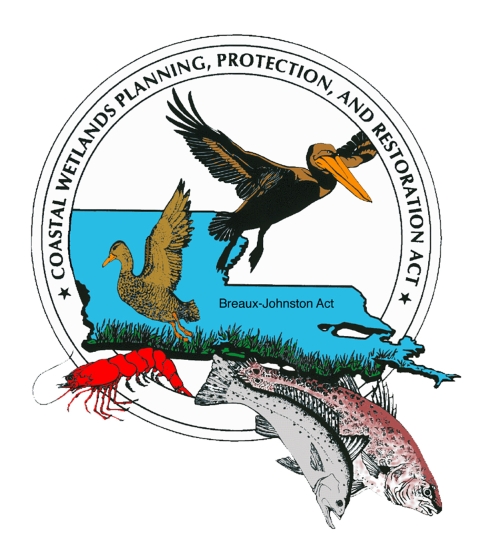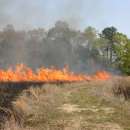Coastal Wetlands Planning Protection and Restoration Act (CWPPRA)
Louisiana supports over 45 percent of the intertidal wetlands in the lower 48 states, but has suffered over 90 percent of the coastal wetland loss in the nation. Current Louisiana coastal wetland loss equals 10.9 square miles/year (6,944 acres/year). This loss rate equals 6,313 football fields annually or one football field every 83 seconds.
From 1932 to 2000, an estimated 1.2 million acres of Louisiana’s coastal wetlands were lost; an estimated 448,000 additional acres are projected to be lost through 2050. The Louisiana Gulf Coast ecosystem supports over 20 percent of the 14 wintering species of waterfowl, 75 percent of Louisiana’s commercial fish and shellfish species, and produces 20 percent of the total seafood harvested in the U.S.
To protect and restore the coast, the U.S. Fish and Wildlife Service’s Louisiana Ecological Services staff works with other agencies in the following programs: the Coastal Wetlands Planning, Protection and Restoration Act (CWPPRA) of 1990, Louisiana’s Coastal Impact Assistance Program, Deep Water Horizon Early Restoration, and the RESTORE ACT (Resources and Ecosystems Sustainability, Tourist Opportunities, and Revived Economies of the Gulf Coast States Act) the Near-Term Louisiana Coastal Area Ecosystem Restoration Study and the Louisiana Coastal Protection and Restoration Program).
CWPPRA established a Coastal Wetlands Conservation and Restoration Task Force with representatives of the Army Corps of Engineers (Corps), the Environmental Protection Agency, the Departments of Interior, Commerce and Agriculture, and the governor’s office to implement restoration projects. CWPPRA has annually provided from $40 million to $85 million in federal funding for small- and medium-scale coastal restoration projects, using revenue from the Sport Fish Restoration and Boating Trust Fund.
From 1991 to January 2017, the Task Force has approved 214 restoration projects to protect and restore more than 97,000 net acres, enhance another 352,000 acres (total of 449,000 acres) costing $1.8 billion. One hundred and eight projects have been constructed or are in construction. The Task Force submitted a detailed Report to Congress in 2016, and does so every 3 years. The U. S. Fish and Wildlife Service, through the LA Ecological Services Office, in 2017 is implementing 27 CWPPRA projects (18,400 net acres/94,000 total benefited acres/ $466 M).”
In response to Hurricanes Katrina and Rita, Congress authorized the Corps to develop the comprehensive Louisiana Coastal Protection and Restoration plan (LACPR), and to provide a Final Technical Report to Congress by December 2008. The Comprehensive LACPR Plan would include a coastal wetland restoration plan, plus combinations of levees and non-structural alternatives to reduce damages resulting from 100-year, 400-year, and 1,000-year storm events.
Coastwide Reference Monitoring System (CRMS)
Coastwide Reference Monitoring System (CRMS) Viewer
Coastal Protection and Restoration Authority (CPRA)
CPRA Coastal Information Management System (CIMS)
Coastal Protection and Restoration Authority (CPRA) Spatial Viewer Portal
Coastal Protection and Restoration Authority (CPRA) Viewer
Strategic Online Natural Resource Information System (SONRIS)
Strategic Online Natural Resource Information System (SONRIS) Viewer
The Louisiana Ecological Services Office, in its Strategic Habitat Conservation Plan, is implementing the following coastal restoration goals and strategies.
Goal 1: Plan, Design, and Implement Sustainable Louisiana Coastal Restoration Projects
Strategies:
- Plan, support, design, and implement freshwater and sediment diversion restoration projects. Support the wise use of Mississippi and Atchafalaya River sediments for wetland restoration whenever possible.
- Plan, support, design, and implement projects (e.g., marsh restoration in outfall areas) which provide synergy with freshwater and sediment diversions to enhance their sustainability.
- Plan, support, and implement other projects that emphasize sustainable restoration techniques (e.g., sediment trapping and marsh restoration).
- Support the development and implementation of new sustainable restoration technologies.
Goal 2: Plan, Support and Implement Coastal Restoration Projects in Areas of Greatest Need and Opportunity within State Master Plan Project Areas.
Strategies:
- Plan, support, and implement restoration projects within State Master Plan areas in coastal basins of greater wetland loss (Terrebonne and Barataria basins), and secondarily basins with the greatest recent hurricane-caused land loss (Mermentau, Breton Sound, Calcasieu-Sabine, and Pontchartrain).
- Seek opportunities to collaborate with other partners/programs to maximize restoration benefits (e.g., leveraged funding from Corps maintenance dredging activities).
Goal 3: Coordinate with Internal and External Partners to Implement Coastal Restoration Projects.
Strategies:
- Coordinate with federal, state, and local governments to develop and implement restoration projects to benefit public lands [e.g., national wildlife refuges, national parks, state refuges, wildlife management areas.
- Coordinate with private coastal landowners to implement restoration projects in areas of need on private property.
- Coordinate restoration project development with other appropriate Service programs, such as Endangered Species, Contaminants, Conservation Planning (Federal Permits), and with other natural resource agencies.
Goal 4: Promote the use of Sound Science in Developing and Evaluating Coastal Restoration Projects.
Strategies:
- Use accepted habitat evaluation techniques, monitoring information, and other technologies (e.g., ecological modeling, hydrologic modeling, etc.) to develop and evaluate coastal restoration project benefits.
- Coordinate with the research community to assist in project development and evaluation.
- Use the principles of adaptive management to assist in developing, evaluating, and managing coastal restoration projects.



